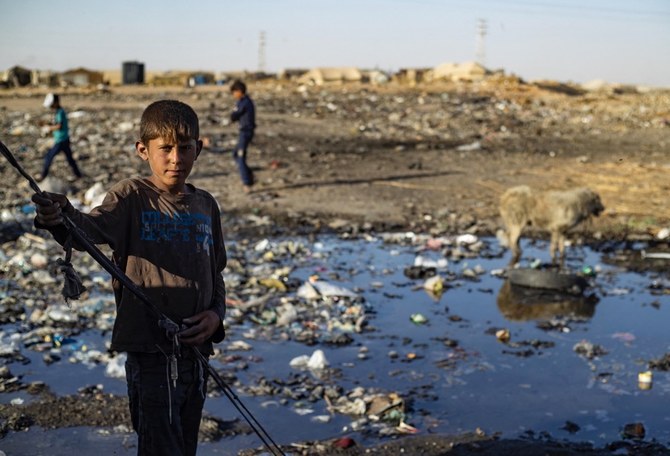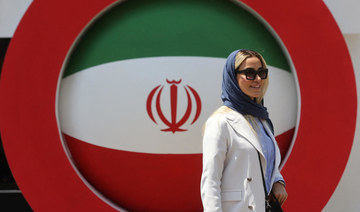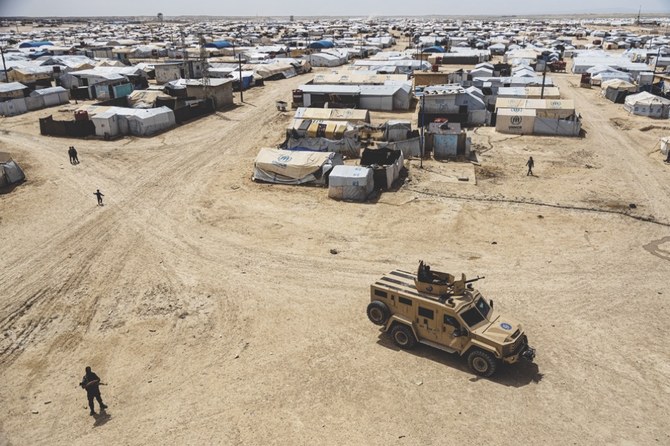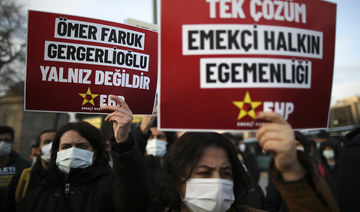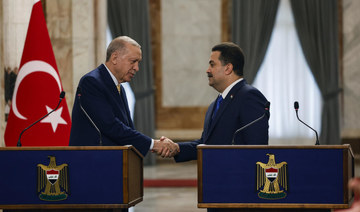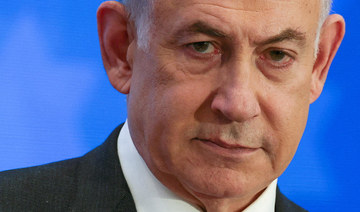DUBAI/QAMISHLI, Syria: After more than 11 years of war, destruction, displacement and hunger, Syrians now face a new horror: Cholera. The disease, caused by contaminated food and water, has spread across several parts of the country in recent months and has already claimed lives.
Cholera, which has been largely eliminated in the developed world, causes diarrhea and vomiting, leading to rapid dehydration, which can kill within hours without prompt treatment. The number of cases in Syria has been steadily on the rise since the summer.
The World Health Organization recorded 24,614 infections and 81 deaths between August to the end of October, with Deir Ezzor, Raqqa, Aleppo and Hasakah witnessing the highest concentrations, while camps for the internally displaced have reported 65 cases.

A child suffering from cholera receives treatment at the Al-Kasrah hospital in Syria's eastern province of Deir Ezzor. (AFP)
Parts of Syria, especially the far-flung governorates, have been facing a water crisis since most water and sewerage infrastructure was destroyed as a result of the civil war that erupted in 2011.
WHO believes the current outbreak was likely caused by the consumption of polluted water from the Euphrates River. Drought, the overpumping of groundwater, and new dams built upstream in Turkey have reduced the once mighty river to a trickle.
Falling water levels have created swamps and stagnant pools along the riverbanks, where raw sewage and other contaminants have collected and festered — the ideal conditions for water- and mosquito-borne diseases to develop.

Jwan Mustafa, co-chair of the Health Board of the Autonomous Administration of North and East Syria (AANES), said the first case of cholera was recorded in the region in September, spreading from Deir Ezzor to Raqqa and later to Hasakah further to the north.
“Our recent statistics based on rapid testing confirm 15,000 cases and 30 deaths,” Mustafa told Arab News. “The pollution in the Euphrates River has been the main cause of plenty of prior viruses and diseases. And now cholera.
“People in the area rely on the river to drink, water their plants and for agriculture. The area by the river is considered the breadbasket of northeast Syria. When Hasakah faces a drought, it relies on the Euphrates’ water, which spells disaster for the governorate.
“We’ve started taking measures to attempt to contain the spread of the disease. Groups have been tasked with adding chlorine to water tanks in attempt to purify them.”

Syrians in Deir Ezzor are forced to use contaminated sections of the Euphrates River for drinking water and irrigation. (AFP)
Authorities are encouraging the public in cholera hotspots to first boil their water before drinking, cooking or watering their crops, to treat water tanks, pipes and other vessels with chlorine, and to regularly wash their hands and sanitize surfaces.
However, given Syria’s crumbling infrastructure, the flight of skilled workers abroad and shortages of basic chemicals and equipment, even these simple preventative measures are difficult to implement.
“The deterioration of the infrastructure has greatly impacted the health sector,” said Mustafa. “We struggle to contain diseases because we lack the resources and expertise. A simple virus can very easily become an epidemic in the region. We are short on laboratories and medications.”
Syria’s health infrastructure has suffered under a devastating mix of aid embargoes, sanctions and war damage. Throughout the civil war, the regime of Bashar Assad has systematically destroyed hospitals in rebel-held areas in defiance of international humanitarian law.
FASTFACTS
• Some 29 countries have reported cholera outbreaks since January of this year.
• Afghanistan, Pakistan and Haiti are among those affected besides Syria and Lebanon.
• UNICEF urgently needs $40.5 million to expand its emergency cholera response in Syria and Lebanon alone.
• The money will support health, water, hygiene and sanitation, risk communication and community engagement.
Meanwhile, deliveries of foreign aid to areas beyond the regime’s control have been deliberately blocked or diverted.
Since June 2021, when regime ally Russia vetoed a UN Security Council resolution allowing eastern Syria to continue receiving cross-border support via Iraq, all UN aid to the region must first pass through Damascus.
This has resulted in severe shortages of medical supplies, poor coordination between health authorities, and limited testing capacity in eastern Syria.
For the people of Raqqa, the outbreak of cholera is only the latest in a litany of crises they are forced to face alone.

A woman suffering from cholera receives treatment at the Al-Kasrah hospital in Syria's eastern province of Deir Ezzor. (AFP)
“The Syrian regime is not helping. People are already feeling haggard and depressed from the daily struggles brought on by the war,” Ahmad, a community activist in Raqqa who declined to give his full name, told Arab News.
“We know we are in trouble, but we also know help will not come from the Syrian regime. We know aid will not come locally or internationally. People do not care anymore. The cholera doesn’t faze us. We’ve been dying from war, chemical weapons and the COVID-19 pandemic.
“We often muse how our lives have become Gabriel Garcia Marquez’s book: ‘Love in the time of cholera,’” he added.

“Cholera doesn’t know borders and lines of control, and spreads along population movements,” said Bertrand Bainvel, UNICEF deputy regional director for the Middle East and North Africa. (Supplied)
In response to the cholera outbreak, Doctors Without Borders, in cooperation with local health officials in Raqqa, has established a local treatment center and two outpatient clinics in the AANES.
However, maintaining adequate food hygiene and access to clean drinking water has become increasingly difficult for most Syrians since the onset of the economic crisis and the currency collapse of 2019, which were compounded by the COVID-19 pandemic in 2020 and the spiraling price of food and fuel since the outbreak of war in Ukraine earlier this year.
According to the World Food Programme, the average price of food items in Syria has risen 532 percent since 2020. As a result, some 12 million people still living in Syria are now considered food insecure.
“Goods have become unattainable,” said Ahmad. “Talk on the street is that death is the best escape. And it will come, if not from cholera or COVID-19, then from hunger.”

A Syrian boy carries a bucket of water at the Sahlah Al-Banat camp for displaced people in the countryside of Raqa, in northern Syria. (AFP)
Conditions in neighboring Lebanon, where millions of Syrians have sought refuge in crowded camps since the outbreak of civil war, are not much better.
Already grappling with its own unprecedented economic crisis, which has thrown 80 percent of its citizens into poverty and left its infrastructure in tatters, Lebanon has also recorded cases of cholera.
Firass Abiad, Lebanon’s health minister, confirmed on Tuesday that the country had recorded 17 cholera deaths and 93 hospitalizations nationwide, including cases in the capital Beirut.
The government is trying to secure 600,000 vaccine doses for the most vulnerable, including prisoners, frontline workers and refugees residing in cramped and often squalid camps.
For most Syrians and Lebanese, who must foot their own medical bills amid rising prices and shattered health infrastructure, the omens are not good.
“I don’t even know where to start. If I get infected I don’t know if I can afford or even have a hospital bed ready for me,” Lina, a Lebanese citizen living in Akkar, a poverty-stricken area of northern Lebanon, told Arab News.
“Life has become unbearably difficult. But, at the end of the day, it’s just another way to die.”




